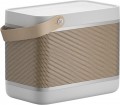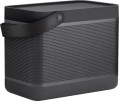Number of channels
—
Mono. The simplest type of acoustics is a single-channel audio system equipped with one speaker. Of course, there is no question of any volume of sound.
—
Stereo. Acoustic system equipped with two speakers responsible for the left and right channels. Allows you to create a minimal illusion of "surround" sound by simulating the displacement of the sound source in the space in front of the listener.
—
2.1. A system of two stereo speakers that create a minimal illusion of "surround" sound, and a subwoofer that provides powerful and rich sound at low and ultra-low frequencies.
Lines
A band is a specific part of the frequency range reproduced by an acoustic system. In single-way acoustics, only universal speakers are used that are responsible for the entire operating range. The presence of several bands means the use of specialized speakers, “tailored” to certain frequencies: for example, in two-way speakers, separate high-frequency “tweeters” are most often provided, and in three-way speakers the frequencies are divided into low, medium and high.
For different frequencies, the optimal speaker design will also be different; thus, the multi-band design allows for better sound quality. On the other hand, single-way speakers are lighter, more compact and less expensive. This is exactly what most portable speakers are, since Hi-Fi sound is not alien to them.
Sound pressure level SPL
The SPL (Sound Pressure Level) parameter determines the sound volume of portable acoustics. This indicator is expressed in decibels (dB). The higher the SPL, the louder and farther the sound produced by the speaker travels. It is important to consider that decibel is a non-linear quantity. In other words, increasing the volume from 20 dB to 40 dB or from 40 to 80 dB does not mean increasing it by 2 times. Therefore, when making an assessment, it is most convenient to refer to comparative tables of noise levels in special sources.
Speaker synchronization
The model supports the ability
to synchronize the operation of several speakers connected to one signal source. This solution allows you to realize truly stereo sound, improve the quality and power of sound reproduction, and also expand the stereo panorama. The only thing is that both speakers must support the appropriate connection type. Different brands may have their own technologies for combining speakers (JBL Connect, JBL PartyBoost, Sony Party Chain), or maybe a universal TWS.
Codec support
Initially, sound transmission via Bluetooth involves quite strong signal compression, which can greatly spoil the experience when listening to music. To eliminate this drawback, various technologies are used (the most popular of which
is the aptX codec). Of course, to use any of the technologies, it must be supported not only by the sound system, but also by the Bluetooth device with which it is used.
- aptX. A Bluetooth codec designed to significantly improve the quality of audio transmitted over Bluetooth. According to the creators, it allows you to achieve quality comparable to Audio CD (16-bit/44.1kHz). The benefits of aptX are most noticeable when listening to high-quality content, but even on regular MP3 it can provide a noticeable sound improvement.
- aptX HD. This codec is a further development and improvement of the original aptX technology, allowing you to transmit sound in even higher quality - Hi-Res (24-bit/48kHz). According to the creators, this standard allows you to achieve signal quality superior to AudioCD and sound purity comparable to wired communication. The latter is often questionable, but it can be argued that overall aptX HD provides very high sound quality. On the other hand, all the advantages of this technology become noticeable only on Hi-Res audio - with quality 24-bit/48kHz or higher; otherwise, the quality is limited not so much by the characteristics of the connection as by the propertie
...s of the source files.
- aptX Low Latency. A specific version of aptX described above, designed not so much to improve sound quality, but to reduce delays in signal transmission. Such delays inevitably occur when working via Bluetooth; They are not critical for listening to music, but when watching videos or playing games, there may be a noticeable desynchronization between the image and sound. The aptX LL codec eliminates this phenomenon, reducing latency to 32 ms - such a difference is imperceptible to human perception (although for serious tasks like studio audio work it is still too high).
- A.A.C. A codec used primarily in Apple portable devices to improve sound transmitted via Bluetooth. In this sense, it is similar to aptX (see the corresponding paragraphs), but is noticeably inferior to it in terms of capabilities: if the sound of aptX is compared with Audio CD, then AAC is at the level of an average quality MP3 file. However, for listening to the same MP3s, this is quite enough; the difference becomes noticeable only on more advanced formats.
-LDAC. Sony's proprietary Bluetooth codec. It surpasses even aptX HD in terms of bandwidth and potential sound quality, providing performance at the Hi-Res level of 24-bit/96kHz audio; there is even an opinion that this is the maximum quality that it makes sense to provide in wireless headphones - further improvement will be simply imperceptible to the human ear.Features
—
Microphone for speakerphone. The ability to use portable speakers as a speakerphone system for conversations on a paired mobile phone. In this mode, the speakers connect to the device via Bluetooth, and the speech is transmitted to the interlocutor using the built-in microphone. The voice of the subscriber on the other end of the line is output not to the speaker of the phone, but directly through the speakers of the speaker system. This is often much more convenient than holding the phone close to the ear, or in situations when your hands are busy. In addition, speakerphone can be very useful if several people need to participate in the conversation.
—
NFC chip. NFC is a short-range wireless communication technology (about 10 cm). It allows for many different uses, but in portable speakers it is usually used as an addition to Bluetooth, making it easier to set up a communication. For example, a smartphone with an NFC module can simply be brought to a speaker with the same function — and both devices will automatically recognize each other, and the user will only need to confirm the communication.
—
Multipoint. The technology used in Bluetooth models allows the speaker to connect to several devices simultaneously. Thanks to this, you can, for example, listen to music from a laptop, and when a call comes in on your mobile phone, switch the speakers to a c
...onversation. Different manufacturers have their own features of this technology, and therefore, if the multipoint function is critical for you, you should separately clarify the details of its operation in the selected model.
— Bass Boost. A function that provides amplification of low frequencies — for powerful and rich bass. Often implemented as a single button, with which you can actually "turn the bass on and off." Bass Boost is more convenient than adjusting low frequencies using an equalizer; in addition, various special technologies can be used to enhance bass.
— Mobile application. The ability to operate the functions and settings of portable sound system through a mobile application for a smartphone or tablet. The device usually communicates with gadgets via the Bluetooth wireless protocol. The proprietary software may include tools for flexible sound adjustment (equalizer, bass boost, etc.), wireless communication management, sound source selection, etc. Also, the ability to update the firmware of portable sound system is often implemented through a mobile application.
— Light effects. Such effects can be different — from the simplest set of lights flashing at a constant frequency to advanced color music systems that produce multi-colored patterns in time with the music being played. In any case, this function has more of an entertaining meaning and does not affect the sound of the device in any way.Battery capacity
Theoretically, a
higher capacity allows to achieve greater battery life, but in fact, the operating time also depends on the power consumption of acoustics — and it can be very different, depending on the characteristics and design features. So this parameter is secondary, and when choosing it is worth paying attention not so much to the battery capacity, but to the directly claimed operating time (see below).
Battery life
Operating time of a portable audio system without connecting to an external power source (network or USB port, depending on the capabilities). Note that manufacturers tend to indicate battery life in their specifications under optimal conditions for energy saving: at low volume, without using additional functions, etc. Therefore, in fact, this indicator may be noticeably lower than the claimed one, and
speakers with a long operating time will not sound at full volume for the specified hours.
Charging time
The time it takes to charge a fully discharged device to 100% charge.

